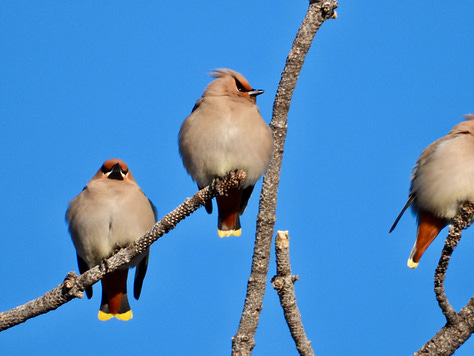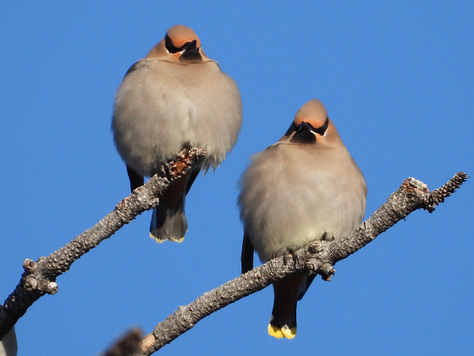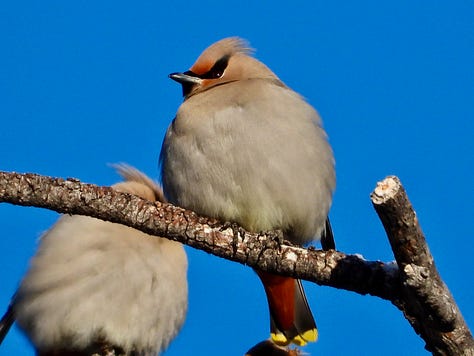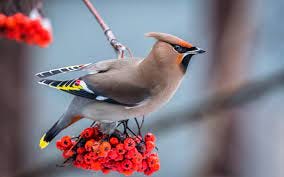Borby Waxwings
One morning, there was a notable, different, high-pitched bird call, not of a singular bird or even calls back and forth, but of a mass of birds, dozens of birds, nearly 80 little birds. I stepped out on the deck to see the top of our snag packed with little, tan-colored birds. Right away, I knew the Waxwings were here.
All throughout this winter, I had seen various reports of Waxwing sightings around Colorado. Seems they are ranging fairly far more south than they normally do. There’s been lots of speculation as to why, but no one was complaining.
The Waxwing is a truly showy bird with its sleek body, crested head, tail and wingtips in bright, primary color blobs and a bandit’s mask. The red wingtips look as though they had been dunked in sealing wax, so the ‘Waxwing’ name stuck.
But these, in my snag, were not sleek, they were ‘tennis ball shaped’. It was 12°F after a three-inch snowfall and the air was cold for April. Almost all birds can ‘floof out’ their feathers in the cold, to hold a pocket of warm air around themselves. I recently heard this referred to affectionally as a ‘borb’, or bird-orb. Perfect description. Nearly all were facing the rising sun to warm up. We counted 78 waxwings before they flew en masse to another tree.



Next came the research.
• Cedar Waxwing? Bohemian? Definitely Bohemian as we noted the rust-colored under tail of the Bohemian. Cedars have a yellow underbelly. There is a Japanese Waxwing as well, but as you might guess, we don’t see those in the United States. They are noisy little birds, their latin name is Bombycilla garrulus, bombycilla meaning ‘silky-tail’, and garrulus meaning ‘talkers’.


• Why now? The Bohemian Waxwings are from far north of here. Canadian birds used to cold, used to being seen as ‘borby’. But, much like most animals, or people, they get on the move when food gets scarce. The main diet of the Bohemian Waxwing is berries, tons of berries, up to several hundred per bird, per day, double their own body weight. Consumption at this rate for a flock of waxwings can strip berry bushes all too quickly. About every 10 years or so, the birds go through an irruption: when their populations grow too quickly and the local areas cannot keep them fed. So, they go on the move. A harsh winter up north can make berries scarce and so they move south for a time to find their weight in berries. Bohemian Waxwings can travel, or rather, wander, great distances, sometimes covering over 3,000 miles. (These observations thanks to bird banding.) It’s one of the sources of the name ‘Bohemian’ Waxwing. The wanderers. Unlike so many other bird species, they are not tied to their nesting grounds and they move to where the feeding is good. They don’t follow predictable migration patterns. Some of the Colorado sightings have been of Cedar Waxwings as well, and their flocks have been known to intermix (but not interbreed) for a time.
• Why so many? Waxwings keep to large flocks, foraging together. The numbers we see now are actually a small portion of what has been previously recorded which was seen to be estimated in the hundreds of thousands of birds together. One flock was recorded in 1908 that was so huge it was 200-300 ft wide and took up to 3 minutes to fly over.


These numbers and eating that much in berries… well, if you’ve ever gorged yourself on a chilled bowl of perfect grapes or blueberries, you know what comes next. And in this, the waxwings do their ecological job of then dispersing a wide variety of seeds consumed everywhere they fly. When these large flocks descend on a berry patch the effect can be like a locust invasion, but just the berries. Consume the inventory and wander on.
• Why here? Waxwings do prefer open, wet areas such as lakes, wetlands, and peat bogs. When they aren’t gorging on berries, they will supplement with insects, found in large supply in wetland areas. Our property has wetlands and a pond. An insect stopover between berry options is a good choice for proteins and calories for the long flights.
There was a time, and it even holds somewhat in common beliefs now, that the arrival of Waxwings was a bad omen. In the Netherlands, they refer to Waxwings as a ’pest bird’, pest as in pestilence, war, and famine to come. Needless to say, they were not welcome. Truly, if hard times made them wander, there may be hard times in the lands to follow. But, for Colorado in 2023, we can welcome this brief sight and enjoy their song while they are here, but they will soon wander on again, moving back north to lands they know. Berries and bugs…. Berries and bugs.
If you happen to see them, be sure to note the sighting on the eBird or Merlin apps so their wanderings can be tracked by ornithologists.
Sources:
- https://what-when-how.com/birds/bohemian-waxwing-birds/
- https://www.audubon.org/news/whats-difference-between-borb-and-floof
- https://en.wikipedia.org/wiki/Bohemian_waxwing
- https://lonesomewhippoorwill.com/2023/01/09/a-briefness-of-bohemian-waxwings/





